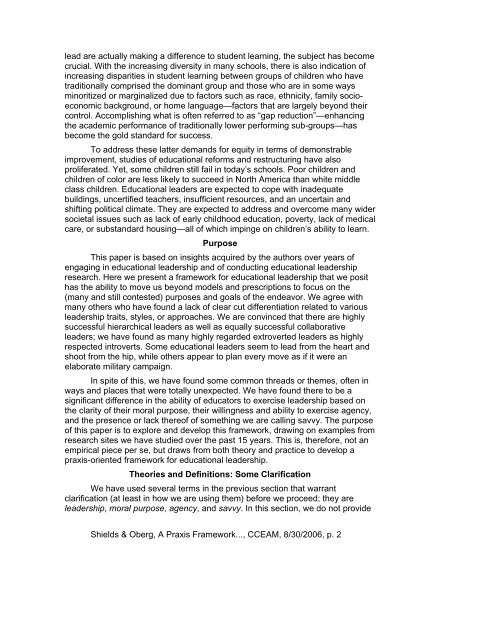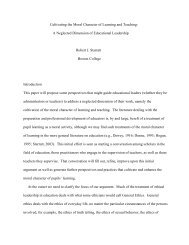SHIELDS M. Carolyn3.pdf
SHIELDS M. Carolyn3.pdf
SHIELDS M. Carolyn3.pdf
You also want an ePaper? Increase the reach of your titles
YUMPU automatically turns print PDFs into web optimized ePapers that Google loves.
lead are actually making a difference to student learning, the subject has become<br />
crucial. With the increasing diversity in many schools, there is also indication of<br />
increasing disparities in student learning between groups of children who have<br />
traditionally comprised the dominant group and those who are in some ways<br />
minoritized or marginalized due to factors such as race, ethnicity, family socioeconomic<br />
background, or home language—factors that are largely beyond their<br />
control. Accomplishing what is often referred to as “gap reduction”—enhancing<br />
the academic performance of traditionally lower performing sub-groups—has<br />
become the gold standard for success.<br />
To address these latter demands for equity in terms of demonstrable<br />
improvement, studies of educational reforms and restructuring have also<br />
proliferated. Yet, some children still fail in today’s schools. Poor children and<br />
children of color are less likely to succeed in North America than white middle<br />
class children. Educational leaders are expected to cope with inadequate<br />
buildings, uncertified teachers, insufficient resources, and an uncertain and<br />
shifting political climate. They are expected to address and overcome many wider<br />
societal issues such as lack of early childhood education, poverty, lack of medical<br />
care, or substandard housing—all of which impinge on children’s ability to learn.<br />
Purpose<br />
This paper is based on insights acquired by the authors over years of<br />
engaging in educational leadership and of conducting educational leadership<br />
research. Here we present a framework for educational leadership that we posit<br />
has the ability to move us beyond models and prescriptions to focus on the<br />
(many and still contested) purposes and goals of the endeavor. We agree with<br />
many others who have found a lack of clear cut differentiation related to various<br />
leadership traits, styles, or approaches. We are convinced that there are highly<br />
successful hierarchical leaders as well as equally successful collaborative<br />
leaders; we have found as many highly regarded extroverted leaders as highly<br />
respected introverts. Some educational leaders seem to lead from the heart and<br />
shoot from the hip, while others appear to plan every move as if it were an<br />
elaborate military campaign.<br />
In spite of this, we have found some common threads or themes, often in<br />
ways and places that were totally unexpected. We have found there to be a<br />
significant difference in the ability of educators to exercise leadership based on<br />
the clarity of their moral purpose, their willingness and ability to exercise agency,<br />
and the presence or lack thereof of something we are calling savvy. The purpose<br />
of this paper is to explore and develop this framework, drawing on examples from<br />
research sites we have studied over the past 15 years. This is, therefore, not an<br />
empirical piece per se, but draws from both theory and practice to develop a<br />
praxis-oriented framework for educational leadership.<br />
Theories and Definitions: Some Clarification<br />
We have used several terms in the previous section that warrant<br />
clarification (at least in how we are using them) before we proceed; they are<br />
leadership, moral purpose, agency, and savvy. In this section, we do not provide<br />
Shields & Oberg, A Praxis Framework..., CCEAM, 8/30/2006, p. 2














